August 22, 2014
Air Date: August 22, 2014
FULL SHOW
SEGMENTS
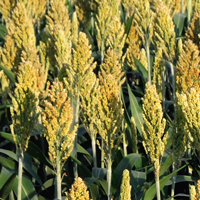
CO2 Can Reduce Food Value
View the page for this story
A study in the journal Nature finds that key agricultural crops grown in a high carbon dioxide environment are less nutritious. Lead author Sam Myers tells host Steve Curwood that atmospheric CO2 levels are expected to reach 550 parts per million by mid-century, which will badly impact human nutrition. (06:40)

Power Shift - Big Battery Breakthrough
View the page for this story
A breakthrough in battery technology could make large-scale energy storage available for renewables both on and off the grid. Researchers at Harvard University say their organic flow-battery would be affordable and efficient. Professor Michael Aziz tells host Steve Curwood how the technology works and why it could significantly improve the distribution of wind and solar power. (07:10)

Chef Bun’s Sustainable Sushi
/ Annie SneedView the page for this story
Bluefin tuna, wild freshwater eel, and other favorite ingredients are in steep decline as sushi becomes increasingly popular. Restaurant owner and sushi chef Bun Lai demonstrates how this Japanese cuisine can evolve and become more sustainable. Living on Earth’s Annie Sneed reports. (05:15)
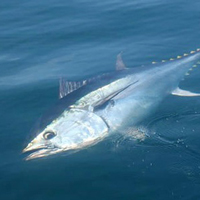
New Protection For Bluefin Tuna
View the page for this story
The bluefin tuna population in the Atlantic is protected, but they are still caught accidentally by long-line fishermen. Carl Safina of the Blue Ocean Institute tells host Steve Curwood that planned conservation proposals from the National Marine Fisheries Service aren't tough enough to protect the population. (06:00)
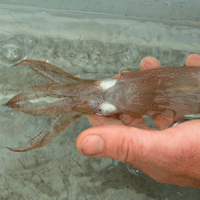
Sound in the Sea
/ Jennifer JerrettView the page for this story
The ocean is a noisy place and human activity is making it worse. Jennifer Jerrett reports that biologists studying the role sound plays in the sea are making surprising discoveries among some squishy marine life forms. (08:00)
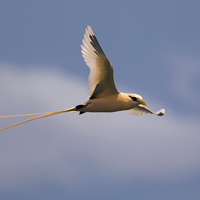
BirdNote: Gliding with Tropicbirds
/ Mary McCannView the page for this story
Above the sun-baked beaches of the Hawaiian islands, glistening white Tropicbirds float, with their long tail feathers streaming out behind them, as Mary McCann reports in today's BirdNote®. (01:55)
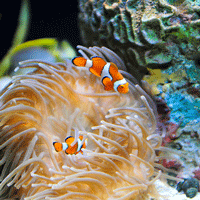
The Extreme Life of the Sea
View the page for this story
Life in the ocean is a longstanding mystery to most humans, and even now that we can travel deep beneath the waves, we've barely scratched the surface. A recent book, The Extreme Life of the Sea, sheds an entertaining and informative light on some of the ocean’s oldest, oddest, and fiercest creatures. Coauthor and biologist Steve Palumbi discusses the sea and its denizens with host Steve Curwood. (11:45)
Show Credits and Funders
Show Transcript
HOST: Steve Curwood
GUESTS: Samuel Myers, Michael Aziz, Carl Safina, Steve Palumbi
REPORTERS: Annie Sneed, Jennifer Jerrett, Mary McCann
[THEME]
CURWOOD: From PRI - this is an encore edition of Living on Earth.
[THEME]
CURWOOD: I’m Steve Curwood. Levels of atmospheric CO2 are now higher than they've been in perhaps millions of years, changing the climate and reducing nutrition in major food crops.
MYERS: Rising concentrations of carbon dioxide really threaten global human nutrition, significantly reducing the levels of important nutrients for human health. We lose about 63 million life years annually from nutrient deficiencies today.
CURWOOD: Also, scientists are starting to understand the importance of sound for sea creatures – and the strange ways some detect noises in the ocean.
MOONEY: The best way to kinda think about how squid detect sound is to kinda think about fruit in Jell-O. The squid being the fruit and the Jell-O being the water column. And how squid detect sound is that essentially the sound wave literally vibrates them or moves them back and forth.
CURWOOD: The noisy ocean and more this week on Living on Earth. Stick around!
ANNOUNCER: Support for Living on Earth comes from United Technologies – innovating to make the world a better, more sustainable place to live.
[NEWSBREAK MUSIC: Boards Of Canada “Zoetrope” from “In a Beautiful Place Out In The Country” (Warp Records 2000)]
CO2 Can Reduce Food Value
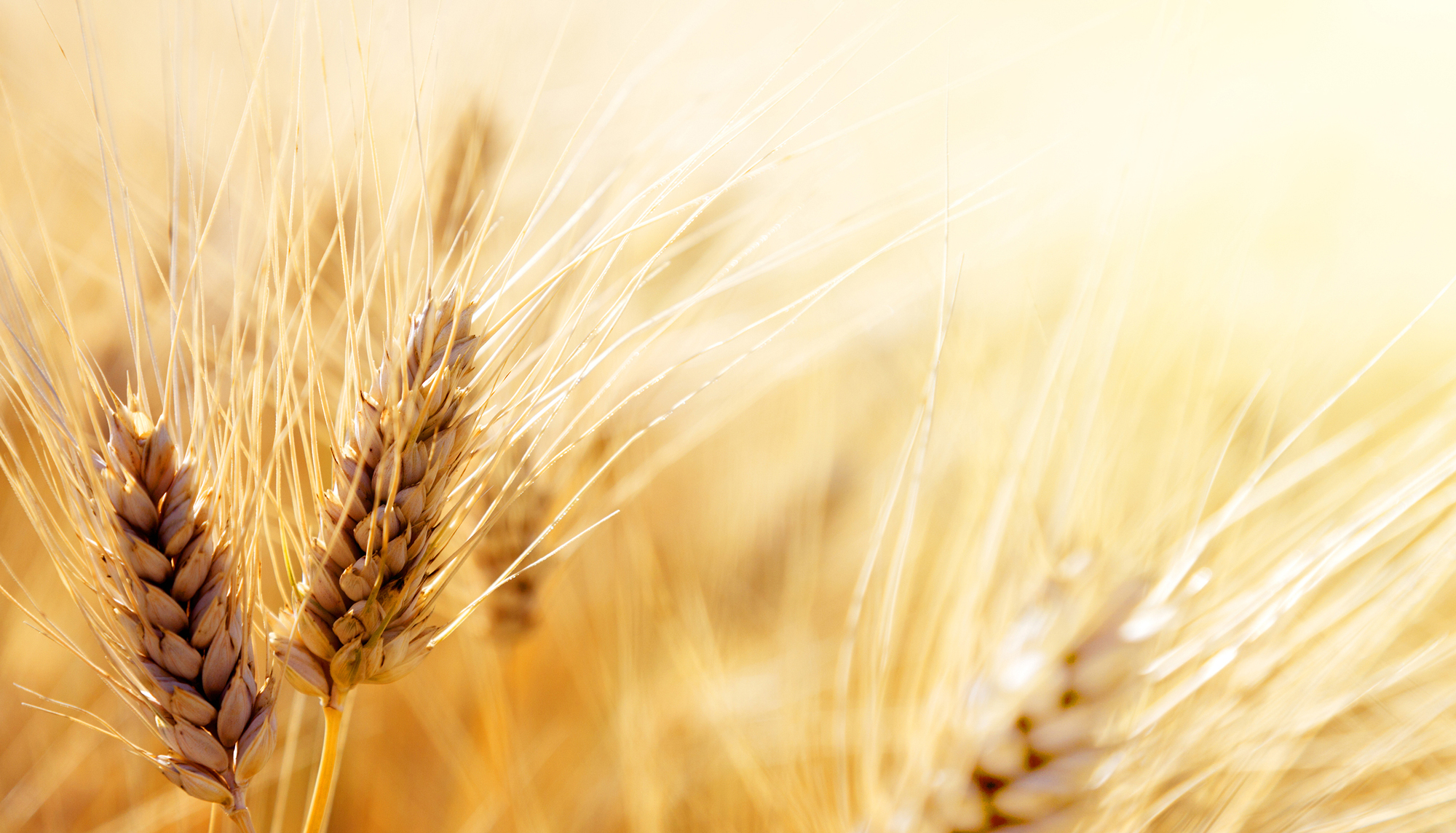
Wheat crops are less nutritious when grown in a high carbon dioxide environment. (Photo: Bigstockphoto)
CURWOOD: From the Jennifer and Ted Stanley Studios in Boston and PRI, this is an encore edition of Living on Earth. I’m Steve Curwood. A study published in the journal Nature finds that staple foods can lose key nutrients when they're grown in air increasingly rich in carbon dioxide. Researchers cultivated 41 different varieties of these crops on three continents to discover how they might be affected by the expected increase of CO2 in coming decades. Samuel Myers is a physician and research scientist in the Department of Environmental Health at Harvard University. He led the study, and joins me now -- welcome to Living on Earth!
MYERS: Thanks so much. Glad to be here.
CURWOOD: So what crops did you look at for this study, and why did you choose them?
MYERS: Well, we looked at a fairly wide variety of crops that included rice, wheat, soybeans, maize or corn, field peas, and sorghum. And we chose them because they represent a fairly broad slice of different plant functional groups that are central to human nutrition around the world.
CURWOOD: It’s what a lot of people eat, in other words.
MYERS: Yes.
CURWOOD: Now, you grew these study crops in an environment that had elevated levels of CO2, carbon dioxide. How much CO2 are we talking about, and how did you do this?
MYERS: Well, so the levels we’re talking about are 550 parts per million. And that’s essentially where the world is going to be by about 2050, there’s very little debate about that. The way we did it is by using what’s called FACE methodology which stands for Free Air Carbon Dioxide Enrichment. Essentially, what you have is open-field conditions where it looks like any other agricultural field except there’s a ring of carbon-dioxide emitting jets, and in the center of the ring is a sensor which tells you the wind direction as well as the carbon dioxide concentration, and when the CO2 falls below your prescribed level the upwind emitters release some additional carbon dioxide.
CURWOOD: So, what were your findings? How did these food crops stack up when they were grown in this high carbon-dioxide environment?
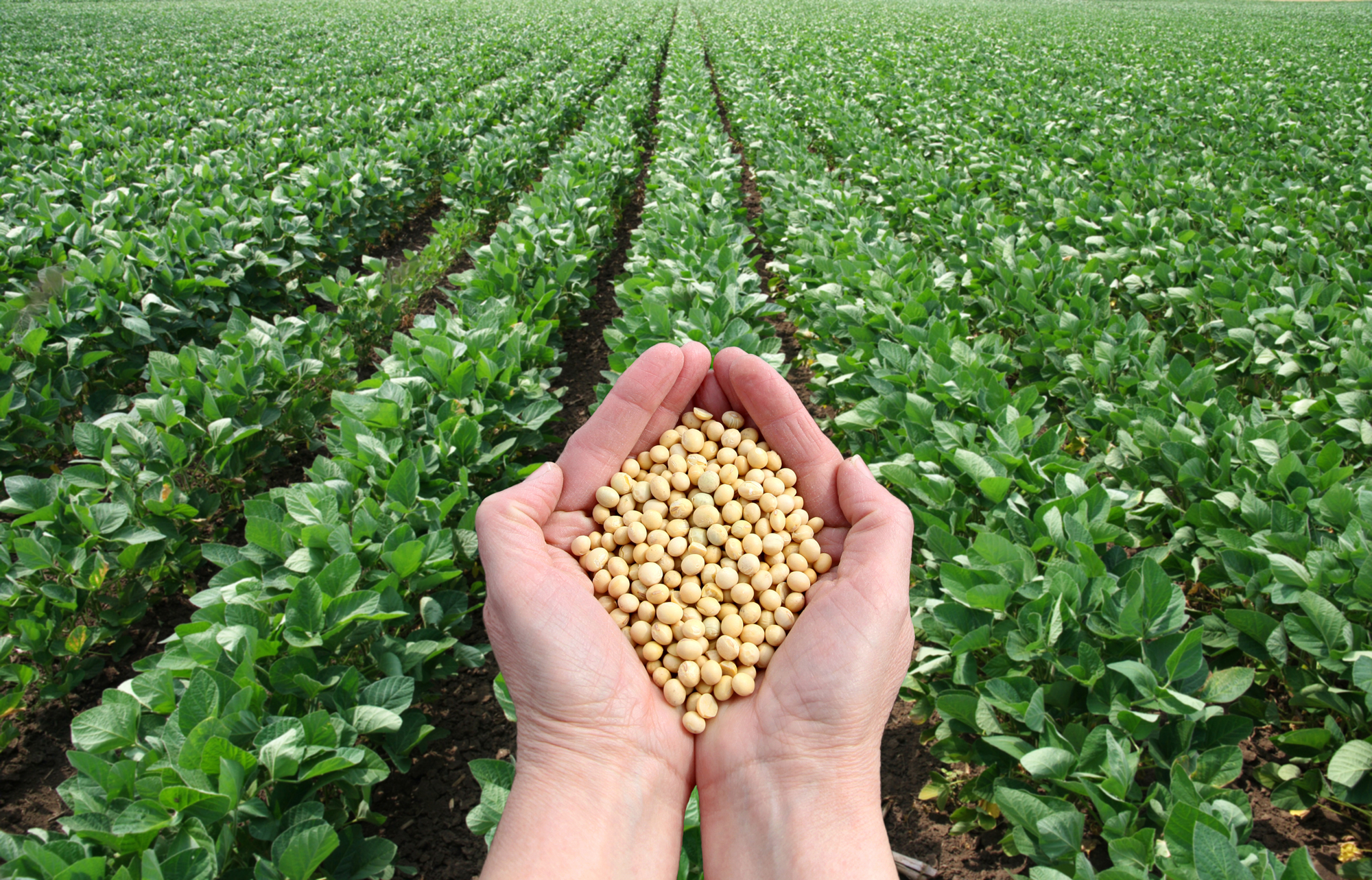
Soy is one of the key agricultural crops researchers tested for nutrition content when grown in a high carbon dioxide environment. (Photo: Bigstockphoto)
MYERS: So what we found is that rising concentrations of carbon dioxide really threaten global human nutrition by significantly reducing the levels of important nutrients for human health in all of these crops. In particular we found significant reductions in zinc, iron, and protein in C3 crops which are grains like rice and wheat, and we found significant reductions in zinc and iron but smaller reductions in protein in the C3 legumes like soybeans and field peas.
CURWOOD: How significant is that reduction in zinc, iron and protein?
MYERS: Statistically it was very highly significant, and in public health terms, I think it’s also very significant. We know that there are roughly two billion people around the world who are suffering from zinc and iron deficiencies today. Without adequate zinc, our immune systems don’t function appropriately. and so we get an increase in really in child mortality from diseases like pneumonia, diarrhea, malaria, measles, and other infectious diseases. For iron deficiency it’s more complex, so we experience iron deficiency as anemia. The risk of maternal mortality rises quite sharply, and there are also impacts on things like IQ and work productivity. When you combine all of those different kinds of effects for both iron and zinc deficiencies together, it’s estimated that we lose about 63 million life years annually from those nutrient deficiencies today.
CURWOOD: How about different cultivars that might be able to do better in a high-carbon dioxide environment?
MYERS: We did actually look at 18 different rice cultivars, and we found that in fact there were some rice cultivars that were more impacted by rising CO2 than others and it may be possible to breed rice cultivars for reduced sensitivity to carbon dioxide, and conceivably other crops as well.
CURWOOD: Now, what about the discussions that carbon dioxide acts something like a fertilizer for plants, causing them to grow bigger, stronger, faster. What does your research say about those views?
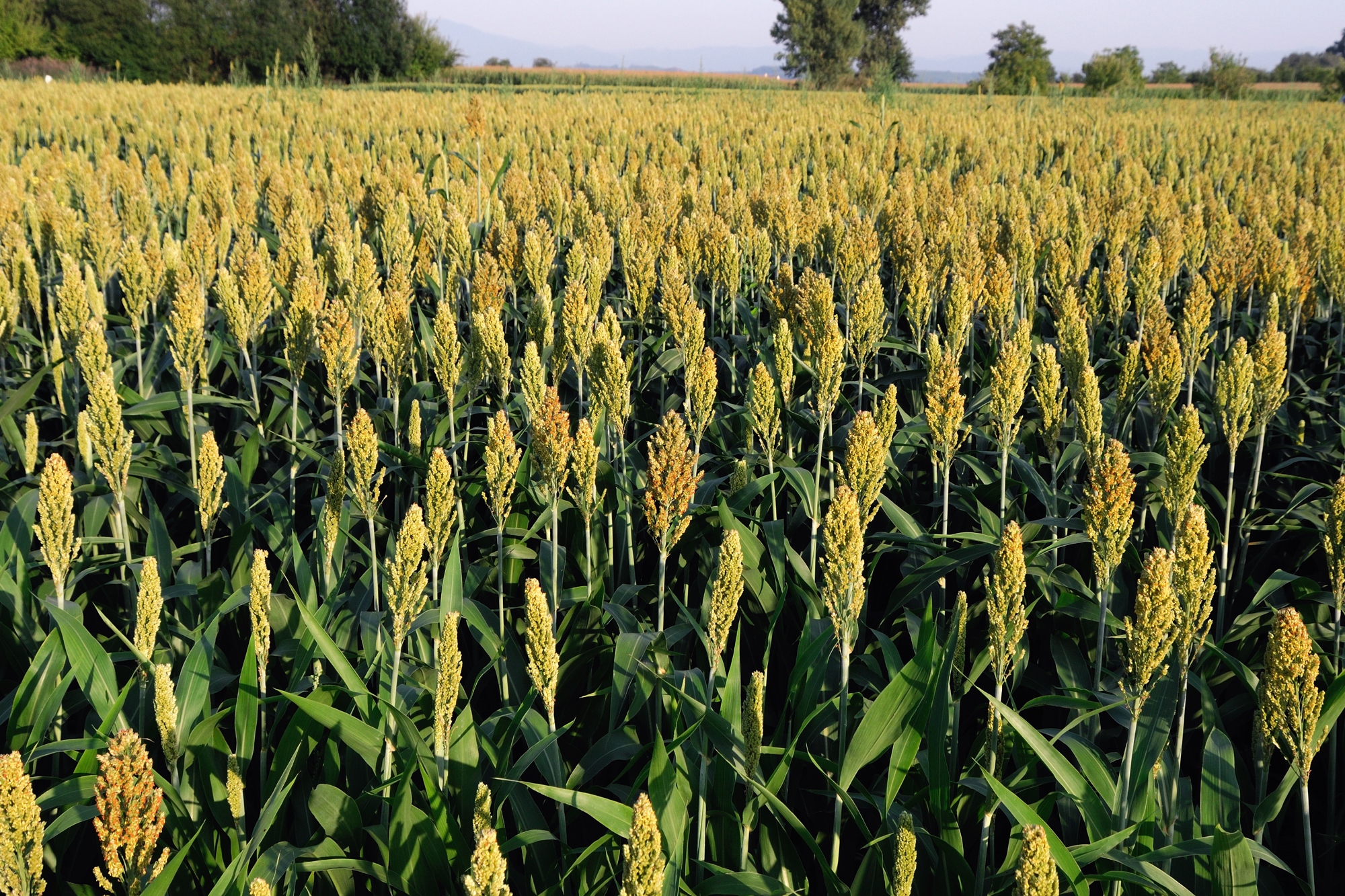
Sorghum is a key agricultural crop around the world. (Photo: Bigstockphoto)
MYERS: There is data that suggests that there’s a small fertilization effect of carbon dioxide that can increase yields although in the context of adequate irrigation, there’s really not that much of a CO2 fertilization effect. I guess what I would say is that over the next 40 years, we need to double global food production in order to keep up with demand, so simply saying we’re going to increase intake is somewhat optimistic given the challenges of even maintaining caloric intake over the next 40 years. The other thing I would say is that if you and I were to simply start increasing our intake of food by five or ten percent in order to offset the reductions in nutrients, we would both be morbidly obese in a matter of months, and so we can’t simply eat more food in order to maintain the same nutrient intake.
CURWOOD: So, it would seem that we’re set to have the 550 parts per million of CO2 over the next 40 years, at the same time we’re expected to see world population go up from our seven billion to nine billion, and the warmer planet likely to have less arable land. How much does this confluence of rather difficult things concern you?
MYERS: Well, I think it’s obviously deeply concerning. We are essentially transforming all the natural systems on the planet in a way that is both pervasive and accelerated. And that transformation will lead to a host of surprises, and it’s very difficult to anticipate how these environmental changes will sort of ripple through ecological systems and ultimately impact our own health and well-being and all we can really say with certainty is that we’ll be surprised many times in the future. To me, this research is an example of one of those surprises.
CURWOOD: Sam Myers is a Physician and Research scientist in the Department of Environmental Health at the Harvard School of Public Health. Thanks so much for taking the time with us today, Dr. Myers.
MYERS: Thanks so much for your interest.
Related link:
Read the Nature study: Increasing CO2 Threatens Human Nutrition
[MUSIC: Dean Fraser “King Of Kings” from Tribute To King Tubby (Firehouse Productions 2009)]
Power Shift - Big Battery Breakthrough
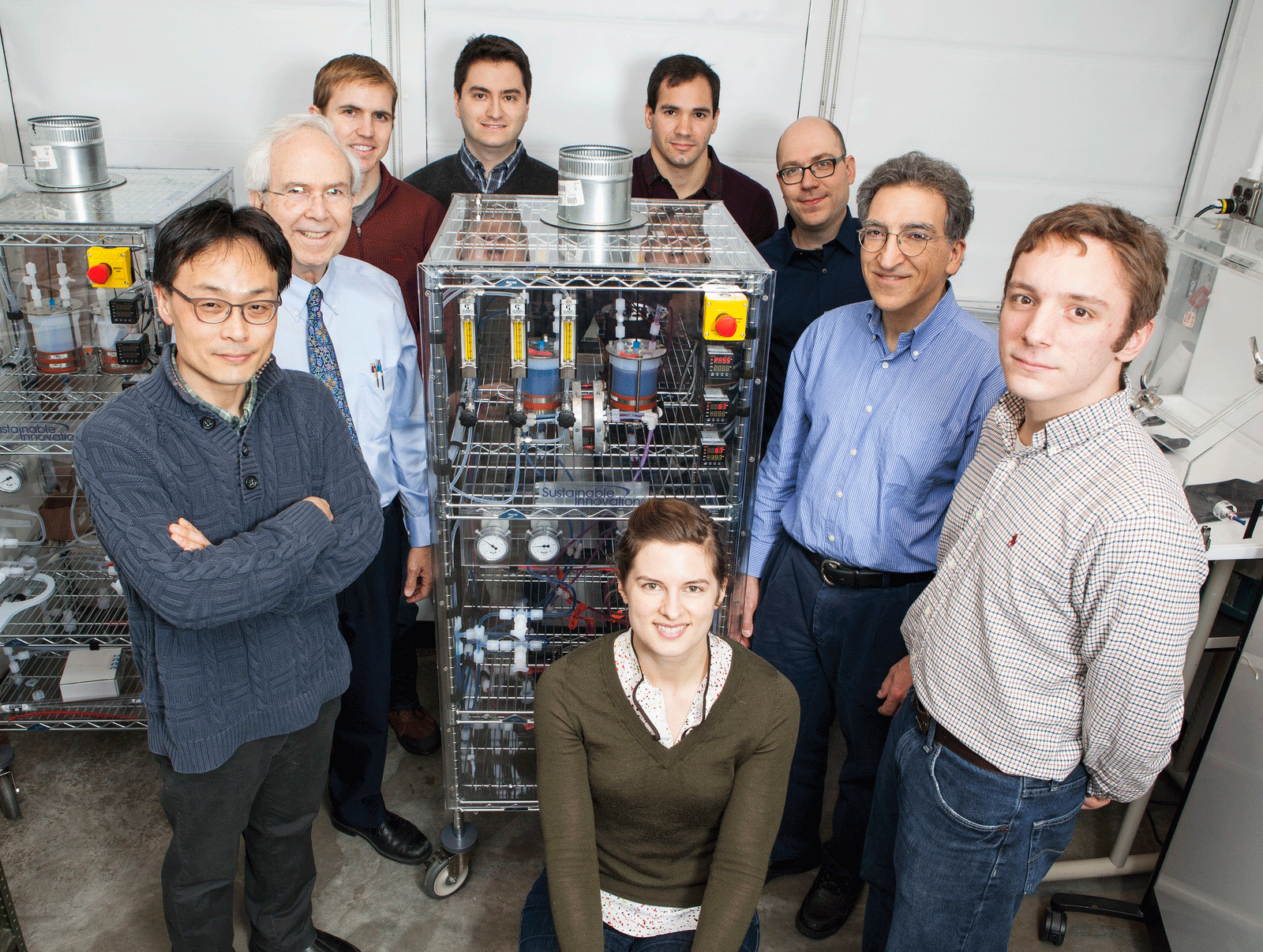
Harvard’s Flow-Battery Team clockwise from left: Dr. Changwon Suh, Prof. Roy G. Gordon, Dr. Brian Huskinson, Dr. Suleyman Er, Dr. Michael Marshak, Prof. Alán Aspuru-Guzik, Prof. Michael J. Aziz, Michael Gerhardt, and Lauren Hartle. (Photo: Eliza Grinnell, Harvard School of Engineering and Applied Sciences)
CURWOOD: Well, maybe concern about the looming climate crisis has you planning to go solar at your home or business. But even if you do, come the evening you have to buy electricity or use very expensive batteries to keep the lights on. Utilities with large scale solar and wind farms also have to manage these intermittent power sources. And much of power from the always-on nuclear and coal plants goes to waste at night because demand is low and it’s too expensive to store the energy. But some Harvard researchers have made a major breakthrough in developing cheap batteries that could store massive amounts of electricity. Michael Aziz of Harvard’s School of Engineering and Applied Sciences is one of the project leaders and he came into the studio - Professor Aziz, welcome to Living on Earth!
AZIZ: Thank you. It’s a pleasure to be here.
CURWOOD: Now, your team has created what’s called this organic megaflow battery, but before you tell us what that means, first of all, just outline what are the problems for conventional batteries for renewable energy sources.
AZIZ: Sure. The two most important measures of the capability of a battery are the amount of energy in can store, and that’s measured in kilowatt-hours. That’s what you pay for in your electric bill, how much energy you’re using. And the rate at which you can deliver that energy out of storage, and that’s the power measured in kilowatts. The ratio of energy to power is very different for different applications, and traditional batteries are very limited in the range of that ratio they can come up with. So, for example, have you ever had a car that wouldn’t start, and you cranked and cranked the starter until the battery died?
CURWOOD: Ummm...it’s that time of year.
AZIZ: Well, the battery lasts maybe ten minutes, 15 minutes, until it’s drained. That ratio of energy to power is the number of hours you can discharge your battery at full power until it’s drained. It turns out for storing wind and solar, you need many hours to days, and there’s no traditional battery that can do that inexpensively.
CURWOOD: In other words, the fundamental problem here, is that you need batteries that can last for a long, long time, and today’s batteries aren’t designed to do that.
AZIZ: That’s right.
CURWOOD: So, your team has created what’s called organic megaflow batteries. What exactly does that mean? Organic...is that good for you to eat?
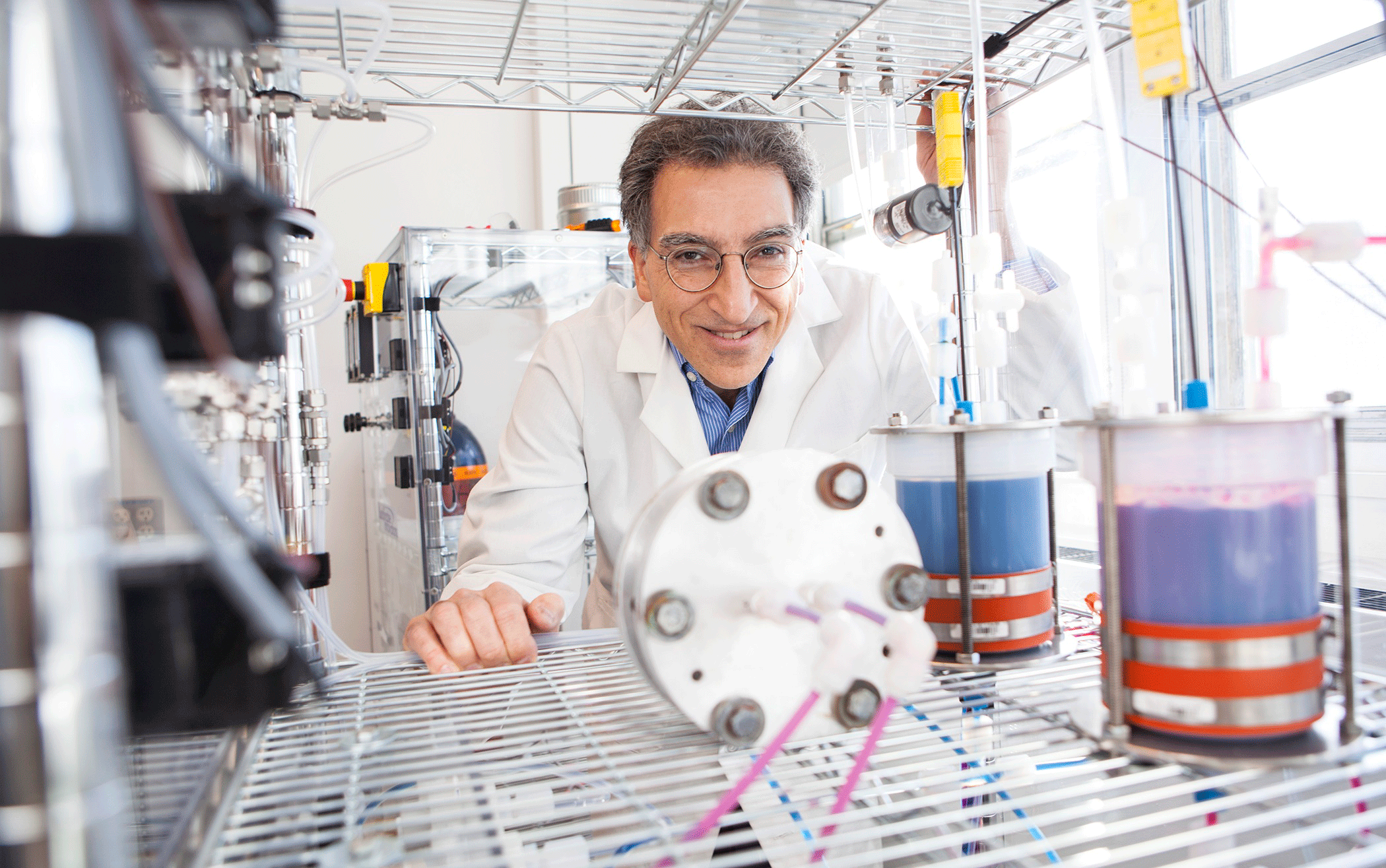
Professor Michael Aziz in his organic flow-battery laboratory. (Photo: Eliza Grinnell, Harvard School of Engineering and Applied Sciences)
AZIZ: Turns out that the molecules we’re using are very, very close to a molecule found in rhubarb. The chemicals are in your green vegetables...you eat them every day. The flow battery is a different concept.
CURWOOD: What is a flow battery?
AZIZ: The flow battery is different from a traditional solid electrode battery because it stores the energy outside the battery container itself in storage tanks full of fluids. It’s a lot like a fuel cell. In a fuel cell you store the energy outside the fuel cell itself, for a fuel cell car it would be hydrogen and air. When you want electricity, you flow those chemicals into the cell past the electrodes where they’re converted to low energy chemicals and they give off the energy in the form of electricity, and you exhaust the low energy product. But for a flow battery, you can’t exhaust the product, you’ve got to contain them so when it’s time to charge up the battery, you flow those product chemicals back into the cell, drive in electricity and convert those chemicals back to the original high energy chemicals that you started with. Now you have a battery.
CURWOOD: So a flow battery...it could be any size that you want. If you store the energy in a tank separate from where the electrodes come together, the bigger the tank, the more energy you could store.
AZIZ: That’s exactly right. You can design the electrodes to give you the power you need, and then you can get arbitrarily large amounts of energy by just bigger and bigger tanks full of chemicals, and that’s potentially a much cheaper way of storing large amounts of energy than stacking up entire banks of solid electrode batteries.
CURWOOD: So there are a few flow batteries already operating out there, large-scale electric plants as I understand it. How correct is that?
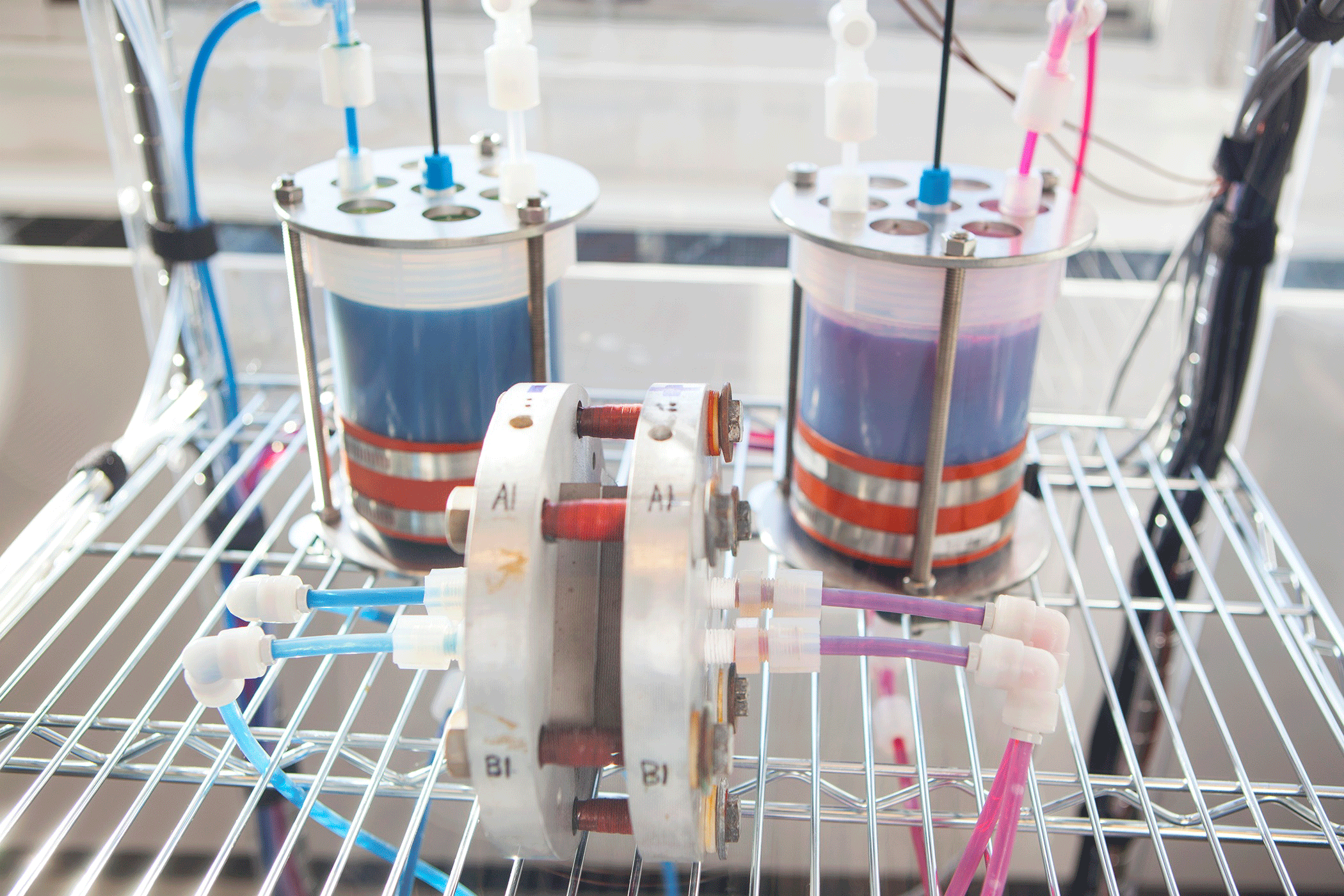
Organic mega-flow battery in the Harvard SEAS lab. (Photo: Eliza Grinnell, Harvard School of Engineering and Applied Sciences)
AZIZ: That’s right. There’s several different flow battery chemistries that are being developed. The most commercially advanced stores energy in the form of Vanadium ions in an aqueous solution, and the problem with that is Vanadium is a rare and expensive metal.
CURWOOD: But you don’t use Vanadium. You use something that, well, you find in food.
AZIZ: As a matter of fact, I noticed that other groups were making progress on designing fuel cells using organics, and so we started looking around for organic molecules that might work well in a flow battery. We noticed this class of molecules in chlorophyll called quinones. When they’re in chlorophyll during photosynthesis, they switch back and forth between oxidized and reduced forms over and over again without any sign of degradation, and that’s exactly the functionality we want in a battery. So we modified them to make them highly soluble in water, and put them in a flow battery, and it works. Performance is terrific. After half a year at this, the performance is rivaling that of Vanadium. We haven’t had a chance to optimize anything yet, so we think that we have a lot of room for improvement ahead of us.
CURWOOD: So, part of your secret sauce is that you’re imitating nature.
AZIZ: That’s right. We find that nature has learned how to do things really well, and in this case going between oxidized and reduced states over and over again without degrading is something nature figured out how to do in order to make photosynthesis work so we’ve adopted that now in a battery.
CURWOOD: So these quinones are really abundant...you can find it in rhubarb, huh?
AZIZ: There’s a quinone in rhubarb that is so, so close to the molecules that we actually have in our first quinone flow battery that some people are calling it a rhubarb battery. Right now what we have comes from crude oil because it’s very cheap and the most important thing is to get storage to be cheap or else it can’t be useful. Ultimately, if we can get it out of rhubarb that would be an extra bonus.
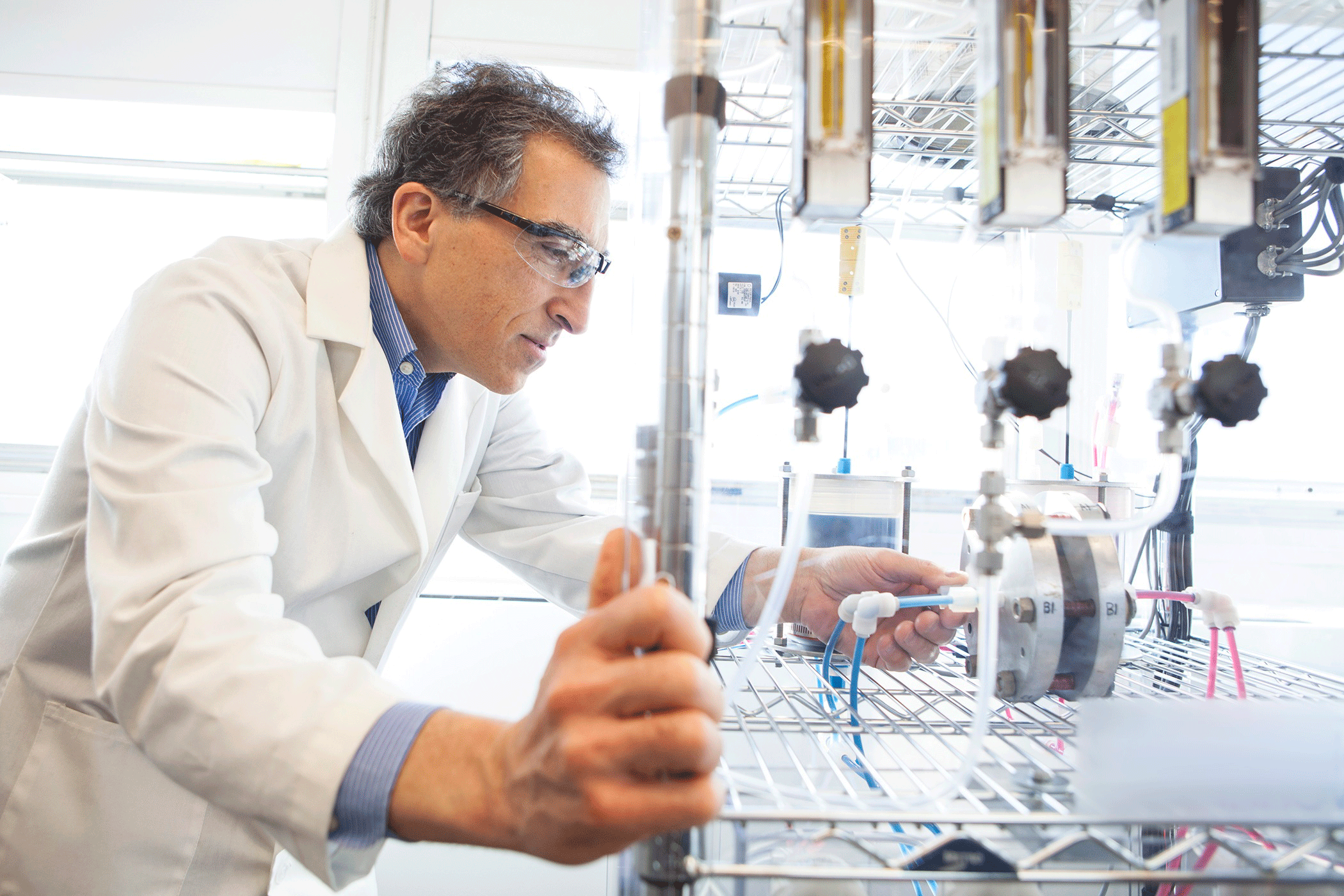
Professor Michael Aziz working in Harvard’s SEAS lab. (Photo: Eliza Grinnell, Harvard School of Engineering and Applied Sciences)
CURWOOD: What would this look like, say, installed in my basement to support home solar cells?
AZIZ: It would be a power conversion unit that would look like an electrical machine, and it would be hooked up to two storage tanks, one for the positive electrolyte and one for the negative electrolyte. Separating the positive and negative that way is a safety feature of flow batteries that you can’t get in solid electrode batteries like lithium ion. There, the positive and negative are all mixed together in the same cell.
CURWOOD: So the two tanks makes it safer?
AZIZ: The two tanks make it safer because the chemicals can’t all mix together at once and give you a catastrophic discharge like you can get in lithium ion batteries for example.
CURWOOD: And these two tanks would be no bigger than, say, a typical oil tank or something?
AZIZ: That’s right. For a typical set of solar panels on your rooftop, you’d have two tanks, the total volume of which would be the size of one home heating oil storage tank in the basement.
CURWOOD: To what extent do you feel your development could really revolutionize our use of solar and wind power?
AZIZ: The way I see it, the biggest problem in us getting most of our electricity from the wind and the sun is their intermittency. We need a battery that can safely and cost-effectively store large amounts of electric energy, and this has a fighting change of being able to do that.
CURWOOD: Michael Aziz is Professor of Materials and Energy Technologies at Harvard’s School of Engineering and Applied Sciences. Thanks so much for coming by.
AZIZ: My pleasure.
Related links:
- Nature Magazine research paper on Harvard’s flow battery
- Nature magazine news summary about the flow battery
- MIT Technology Review
[MUSIC: Meshell Ndegecello “Forget My Name” from Comet, Come To Me (Naïve Records 2014)]
CURWOOD: Coming up…Listening in on squishy creatures in the ocean -- That's just ahead on Living on Earth – stay tuned.
[CUTAWAY MUSIC: Kenny Burrell: “Chitlins Con Carne” from The Artist Selects (Blue Note Records 2005)]
Chef Bun’s Sustainable Sushi

Miya's "The Best Sushi South of the Mason Dixon Line," an Americana sushi roll inspired by Southern cuisine and its Native American, African and European roots. (Photo: Wikipedia)
CURWOOD: It's Living on Earth, I'm Steve Curwood. Think sushi and you’re likely to picture a dark red slice of tuna on gleaming white rice. A savory choice for you, maybe, but probably not for the ocean. Bluefin tuna, wild freshwater eel, and other sushi ingredients are in steep decline as more and more people develop a taste for this cuisine. Some see a possibility – and a necessity – for the ancient tradition of sushi to evolve and become more sustainable. One of these people is restaurant owner and sushi Chef Bun Lai. Earlier this year, Living on Earth's Annie Sneed went along to learn and taste - more.
[FOOD PREPARATION, WASABI STIRRING]
SNEED: Chef Bun Lai and his team are at the New England Aquarium in Boston. They peel tin foil from giant platters, revealing hundreds of pieces of sushi, that range in color from neon green to fiery red. Tonight, Chef Bun is delivering a lecture on sustainable sushi and tasty tidbits to illustrate it.
LAI: Tonight I brought five different types of rolls, two vegetable rolls. We’ve got catfish with okra and African spices; squid, squid ink, and broccoli; mussels from New Zealand; broccoli, roasted garlic and Chinese black bean; sweet potato with kudzu dust and fire ants.
SNEED: Of course, Bun isn’t really serving kudzu dust and fire ants, but eating invasive species is part of his message. Thirty years ago, Bun’s mother started her sushi restaurant, Miya’s, in New Haven, Connecticut. As a teenager, Bun joined his mother in the restaurant’s kitchen.
LAI: Back in the day, it was a traditional sushi restaurant and we served all the types of seafood that are popular today.
SNEED: Chef Bun still works with his mother, but the menu’s changed.
LAI: The reason we stopped serving tuna, shrimp, and a slew of other popular sushi ingredients that everyone expects today, is to be able to show people and to challenge ourselves to see if we can thrive as a business without using those ingredients that are so incredibly destructive on so many different levels.

Caged Blue fin tuna in the Mediterranean. (Photo: Greenpeace)
SNEED: Miya’s menu now features invasive species, such as lion fish and shore crabs, and eight pages of vegetarian sushi. And Bun connects with scientists and organizations like the New England Aquarium to deliver sustainable food.
ANNOUNCER: Tonight is all about making those connections between the ocean and what you’re going to have on your plates later, so please join me in welcoming Bun Lai.
[APPLAUSE]
LAI: Well thank you so much for having me.
SNEED: Tonight at the Aquarium, about fifty people - grandfathers, college students, even toddlers - have come for Bun and his innovative sushi. Bun’s dressed in jeans and a black shirt. He’s in his early forties and doesn’t look the stern sushi master. He slips in jokes in a deadpan tone. If you don’t pay attention, you’ll miss his humor.
LAI: The first thing you should try is the Asian shore crab. You just kind of eat it with your fingers, it’s all finger food here and hopefully it doesn’t bite your tongue. If it does, it’s never broken skin, I’ll assure you.
[LAUGHTER]
SNEED: His audience obediently picks up the little crabs and starts chewing.
[CRUNCHING]
MAN: Certainly unusual. Yeah, it’s tasty!
SNEED: They try it all, from mussels to sweet potatoes.

Sushi by Hiroshige in Edo period. (Photo: Wikipedia)
WOMAN: This is the “Kiss the Smiling Piggy Vegetarian Sweet Potato Roll”.
SNEED: After the lecture, people stick around to talk with Bun, and to score a few more pieces of sushi.
HIGH SCHOOL STUDENT: The sushi was absolutely delicious and I was really excited to hear Bun talk, he’s an inspiration. I’m a high school student who’s really interested in sustainable seafood and following that in college, so it’s really great to have a role model like Bun.
MAN 2: The lecture was very fun. This is the first time I’ve ever tried sushi, I’ve never been very excited about it. It was interesting.
SNEED: Alright, do you think you’ll eat sushi again?
MAN 2: Ah, probably not.
SNEED: The kids were probably least intimidated by Bun’s strange ingredients.
GIRL: The crabs you can eat just like popcorn, they’re really crunchy and good.
SNEED: And the message of eating invasive species hit home.
WOMAN: Oh, I thought it was amazing, this thought of, why don’t we eat up what we don’t want invading? I have to say, I never thought of it that way before.

Chef Bun Lai, owner and head chef of Miya’s. (Photo: Wikipedia)
EVENT STAFF: I have extra plates if you’d like to take some sushi home!
SNEED: Bun knows his unusual version of this very popular cuisine isn’t for everyone.
LAI: Throughout my career, it’s been a situation where often people will walk out because we hadn’t been carrying tuna or shrimp or freshwater eel - the most popular sushi ingredients. So if they don’t think outside the box, they’re not going to think that it’s sushi. But food has been evolving since the beginning of time. In the origins of sushi, when it first started out thousands of years ago, most of the popular ingredients that we eat today and think of as sushi weren’t considered ingredients for sushi anyway.
SNEED: Bun and a handful of other sushi masters are helping that evolution along. He hopes that people leave his lecture not only with a full stomach, but also determined to eat only sustainable sushi. For Living on Earth, I’m Annie Sneed.
Related links:
- Check out Chef Bun Lai’s restaurant, Miya’s Sushi, in Connecticut
- More on Chef Bun Lai
- The New England Aquarium
- Monterey Bay Aquarium Seafood Watch
New Protection For Bluefin Tuna
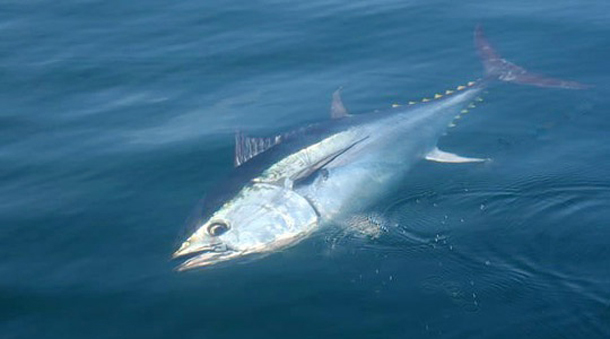
Populations of Bluefin Tuna have sharply declined in the Atlantic Ocean. (Photo: Paul Murray, Courtesy of Large Pelagics Research Center)
CURWOOD: There are nowhere near as many of the huge magnificent Blue Fin Tuna as there used to be off the shores of America, but perhaps rules proposed by the National Marine Fisheries Service may help their population recover. For an assessment, we called up Carl Safina. He's President of the Blue Ocean Institute who's both a fisherman and a strong voice for conservation - Carl, welcome back to Living on Earth!
SAFINA: Hi there, thanks for having me.
CURWOOD: Let’s go to the basics here. Why are bluefin tuna in such as steep population decline right now?
SAFINA: Well, it’s not clear they’re in a steep decline right now, but they’re in a big hole. They sort of have fallen and they can’t get up. In the 1960s boats from Japan went into their breeding grounds in the Gulf of Mexico, and they caught an incredible amount of bluefin tuna there while they were trying to breed. After that, other boats caught the babies for canning. So you have the
Japanese taking the breeders, you had the canners taking the babies. Then in the 70s and the 80s
Americans got into the sushi business, and the population has never recovered from the hole that it went into.
CURWOOD: So talk to me about this plan by the National Marine Fisheries Service to protect the
bluefin tuna.
SAFINA: The idea is to try to have fewer of these bluefin tuna killed on their spawning grounds while they are spawning. People are fishing in there with long lines, which are a long fishing line, about 25 miles long. It has hundreds of baited hooks. They’re allowed to keep a couple of bluefin tuna and other things that they catch, and so they continue to have incentive to be fishing in the breeding area catching these giant tuna with can weigh 1,000 pounds or more, and keep a couple.
They’re extremely lucrative, but they kill others in the process and they discard them because they’re not allowed to keep them. This is a proposal that attempts to improve on the situation.
CURWOOD: 25 miles of long line. What other fish are they catching?
SAFINA: They catch a lot of things they’re not intending to catch, including marlin and sailfish, which they cannot sell - that’s supposed to protect them - but a lot of them get killed anyway. So those populations of some of those marlin are in very, very bad shape. They catch a lot of sharks, they catch sea turtles, in some places they catch a lot of sea birds, and they’re very bad at targeting things well even if they’re fishing for something like, let’s say, swordfish, they can catch a lot of juvenile swordfish that are too small to sell - that come up dead.
CURWOOD: Well, how would these new regulations from the National Marine Fisheries Service help?
SAFINA: It would let them fish there in a smaller area for a shorter amount of the season. So you might say that’s an improvement, or you might say it doesn’t really go far enough.
CURWOOD: In your view?
SAFINA: Not far enough.
CURWOOD: Because...
SAFINA: Well, because these fish have been in a deep hole for many decades, and I don’t think you should be fishing for a deeply depleted fish while it is trying to reproduce. I think that if any place should be a protection zone where the survivors have finally managed to get themselves to in order to spawn is a place where they should just spawning and not dying.
CURWOOD: How do you police something like this?
SAFINA: You can police it on the fishing ground which is very very difficult to do, or you can police it at the dock, but there’s an incentive to pass fish among boats, there’s incentive to hide fish. There will be people who probably will decide to do some cheating.
CURWOOD: The National Marine Fisheries Service says they’ll have observers and they’ll even have cameras on these boats. How effective might that be?
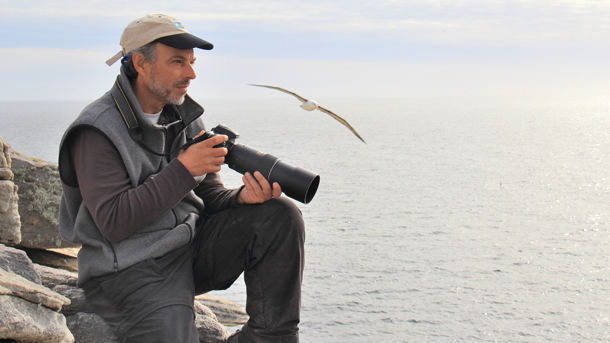
Carl Safina (Photo: Pat Paladines)
SAFINA: I think in the US it’s probably pretty effective. The observers and the cameras are for two reasons. One is because there can be incentive to try to bribe the observers and the other is because observers cannot stay awake 24 hours a day or be looking in all directions at once.
CURWOOD: What are the different sides of this argument? What about the folks that say this goes too far?
SAFINA: There are people who say there are plenty of bluefin tuna, there are plenty of those who say they’re recovering well. There are people who say a lot of things, and I think all those things are partly true, but if you compare the number of fish to the number of fish that are supposed to be, it’s vastly fewer than it was when I was a child, and if we could get it back, which could happen in a reasonable amount of time, then you could catch a lot more of them, more sustainably, from a population that is much bigger and recovered from the small population that exists now.
CURWOOD: So what would be the ideal plan for you to regulate the bluefin tuna?
SAFINA: In a perfect world, we would not catch these fish at all for about five years. We would just give them a break and let the young ones grow up, let the big ones spawn, and let the good times roll, and then reassess it and see if we want to resume fishing at that point, and how many we could take.
CURWOOD: If consumers are concerned about this, what should they do?
SAFINA: There are a couple of different levels at which consumers could act on their concern.
One is not eating any bluefin tuna at all. The other thing is to try not to eat animals that are caught with long line fishing gear, and there are a couple of groups - my group Blue Ocean Institute - and the Monterey Bay Aquarium - put out guides to sustainably-caught fish that can help you try to figure out what fish are caught with relatively clean, relatively sustainable techniques from better managed fisheries.
CURWOOD: Carl Safina is the Founder of the Blue Ocean Institute. Thanks for joining me today.
SAFINA: It was a pleasure as always. Thank you.
Related links:
- Visit the NOAA website for further information on the amendment
- Visit the Safina Center at Stony Brook University's site to learn more.
[MUSIC: Hot Tuna “Keep On Truckin” from The Best Of Hot Tuna (BMG Music 1998)]
Sound in the Sea
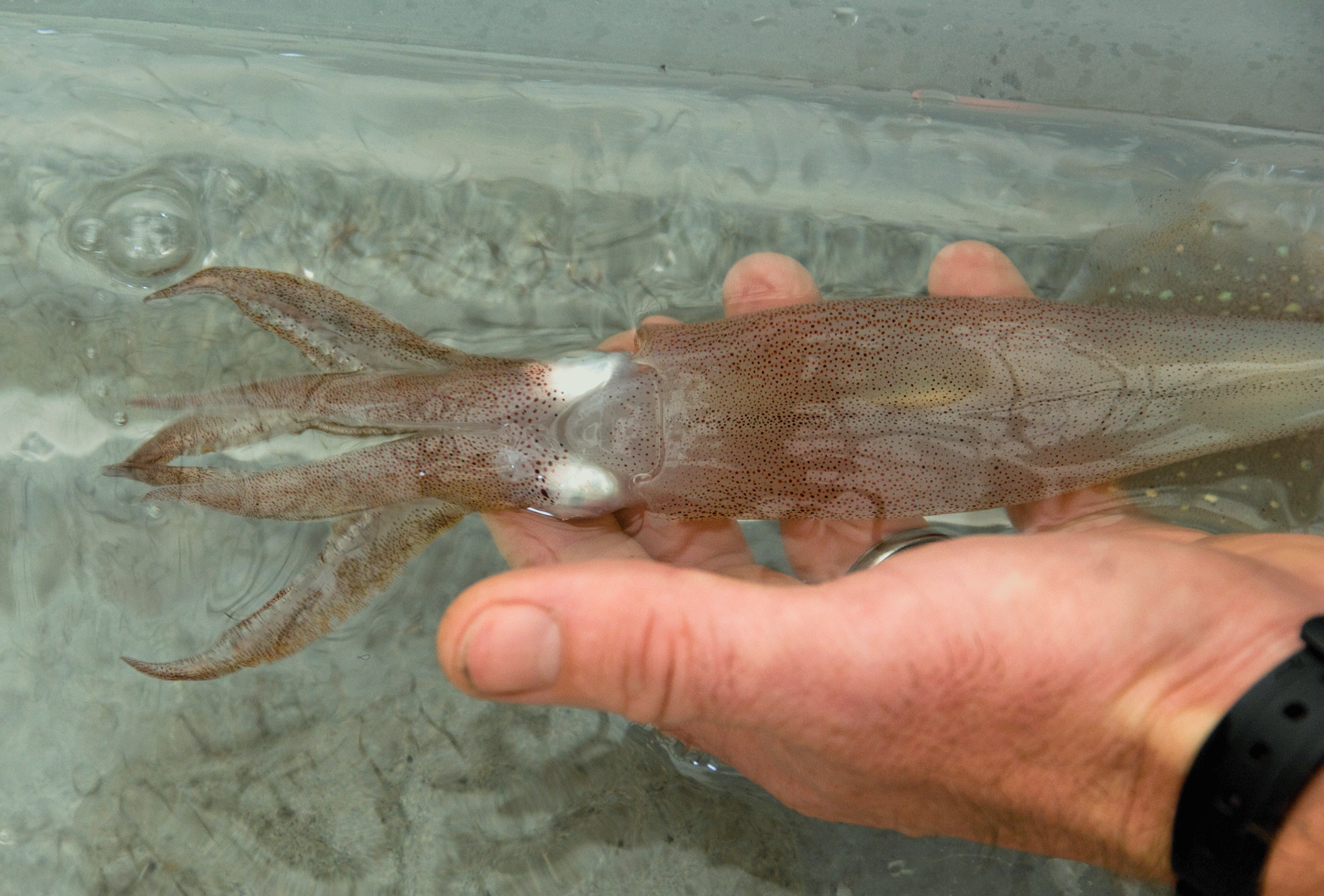
Aran Mooney working with squid in his lab (Photo: Woods Hole Oceanographic Institution)
CURWOOD: Oceans cover 70 percent of the planet -- and though we've travelled over them for millennia, and dived deep under them for over a century, they still hold many secrets. Among those mysteries are many of the strange creatures beneath the waves -- and marine biologists are getting a new understanding of the role that sound plays for some of them. And as the sounds we humans create in the seas increase, deepening that understanding becomes more urgent. Reporter Jennifer Jerrett visited the Woods Hole Oceanographic Institution, and has our report.
[SOUNDS OF D-TAG SIGNAL AND BOAT SPLASHING ON WAVES. MAX BERNARD OFF MIC: "SO ARAN, ARE YOU READY?"]
JERRETT: On the video I'm watching at the Woods Hole Oceanographic Institution, four scientists are clustered toward the front of a 27-foot Boston Whaler. One guy is hanging over the water off a skinny platform at the front of the boat. He's got an ankle wrapped around the rail to keep from falling in. He's very gingerly trying to attach an acoustic monitoring tag, or a "D-Tag" to a dolphin.
[SOUNDS OF PLACING THE TAG. PERSON ON THE BOAT SAYING “THERE YOU GO!"]
JERRETT: Aran Mooney is the team leader for this operation.
MOONEY: I really love working with, um, that dolphin or that squid. I really like kinda being able to work with and address an animal that I can see and hold and touch and look at.
JERRETT: Aran Mooney is a marine biologist at the Woods Hole Oceanographic Institution. He specializes in sensory ecology and bioacoustics. This means he studies the role that sound plays for animals in the ocean.
[SOUNDS OF DOLPHIN CLICKS]
JERRETT: The dolphins he studies are well-known sound specialists. They use sonar, or echolocation, to map their underwater world.
[MORE DOLPHIN CLICKS]
JERRETT: To put it in human terms, they basically ‘see’ with sound. And dolphins also use sound to communicate.
[SPLASHING AND DOLPHIN CHIRPS, THEN LOW-FREQUENCY RUMBLING SOUND OF BLUE WHALE]
JERRETT This blue whale uses sound to communicate, too, and it's possible blue whales are calling to each other across entire oceans. Over hundreds, or even thousands of miles.
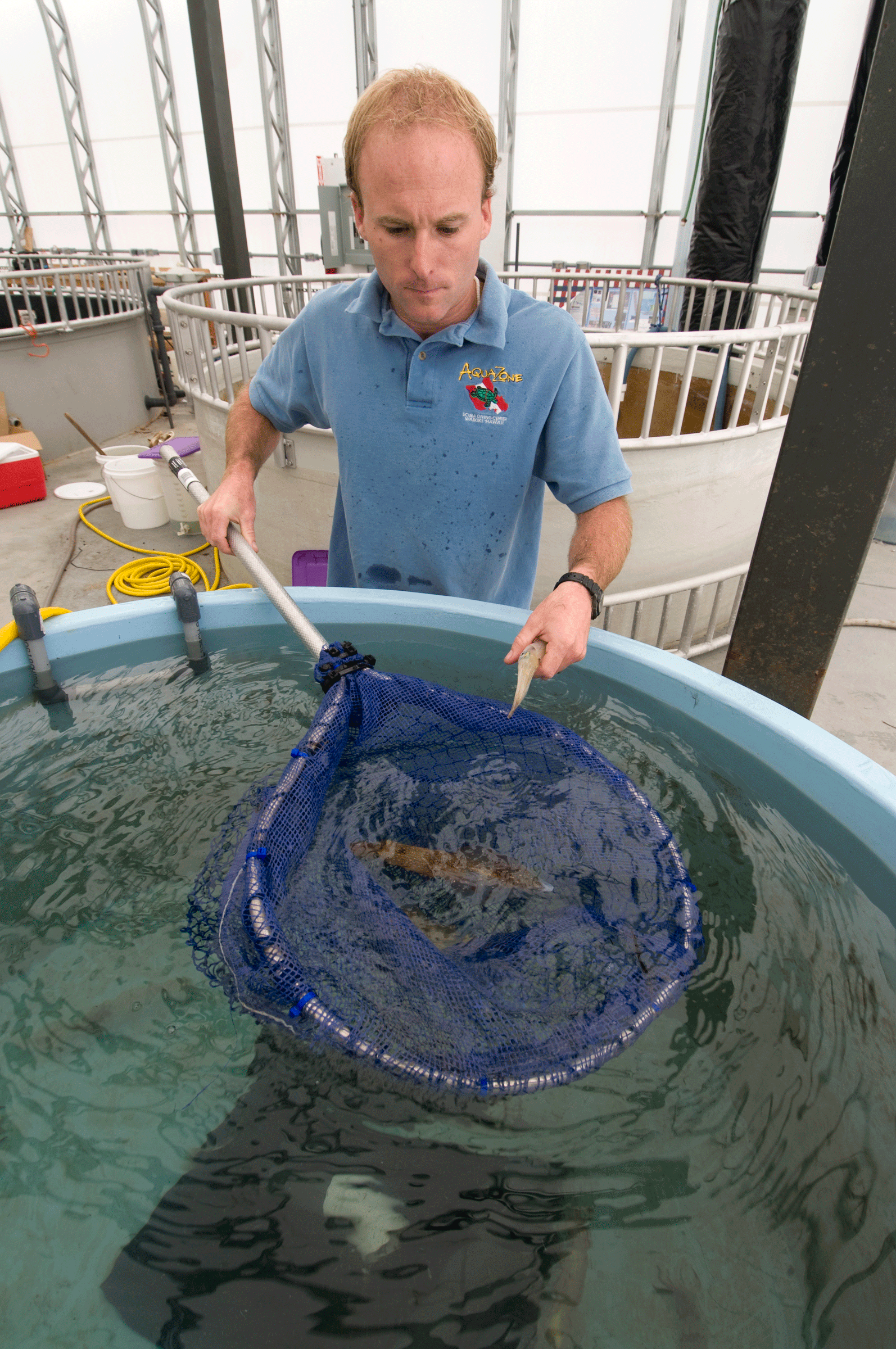
WHOI biologist Aran Mooney gently lifts a squid from a tank in the Environmental Systems Lab. (Photo: Woods Hole Oceanographic Institution)
JERRETT: Of course, humans make sounds in the ocean too, and some of those sounds, like boat traffic and offshore industrial activity, are making the ocean a lot noisier.
[OFFSHORE INDUSTRIAL NOISE]
JENSEN: So, one of the things that are concerning us about marine mammals these days is noise pollution.
JERRETT: That's Frants Jensen, another bioacoustics researcher at the Woods Hole Oceanographic Institution.
JENSEN: We're putting out a lot of noise into the ocean.
JERRETT: As Jensen’s D-tag recordings reveal.
JENSEN: So. The sequence I'm gonna play here is from a bottle nosed dolphin instrumented with another D-Tag. You'll hear the animal swimming around and then you'll hear a loud vessel passing close by. And this is not just a one-time occurrence. This is in a very busy area with respect to recreational vessel traffic.
[SWISH SOUND OF DOLPHIN SWIMMING FOLLOWED BY SOUND OF VESSEL FAR AWAY]
JENSEN: So now you can hear the vessel approaching.
[SOUNDS OF VESSEL GETTING CLOSER, PASSING AND MOVING AWAY]
JENSEN: So as you can hear this is quite an increase in noise levels and in noise that actually stretches quite far up into echolocation frequencies. So this can be pretty important for the animals.
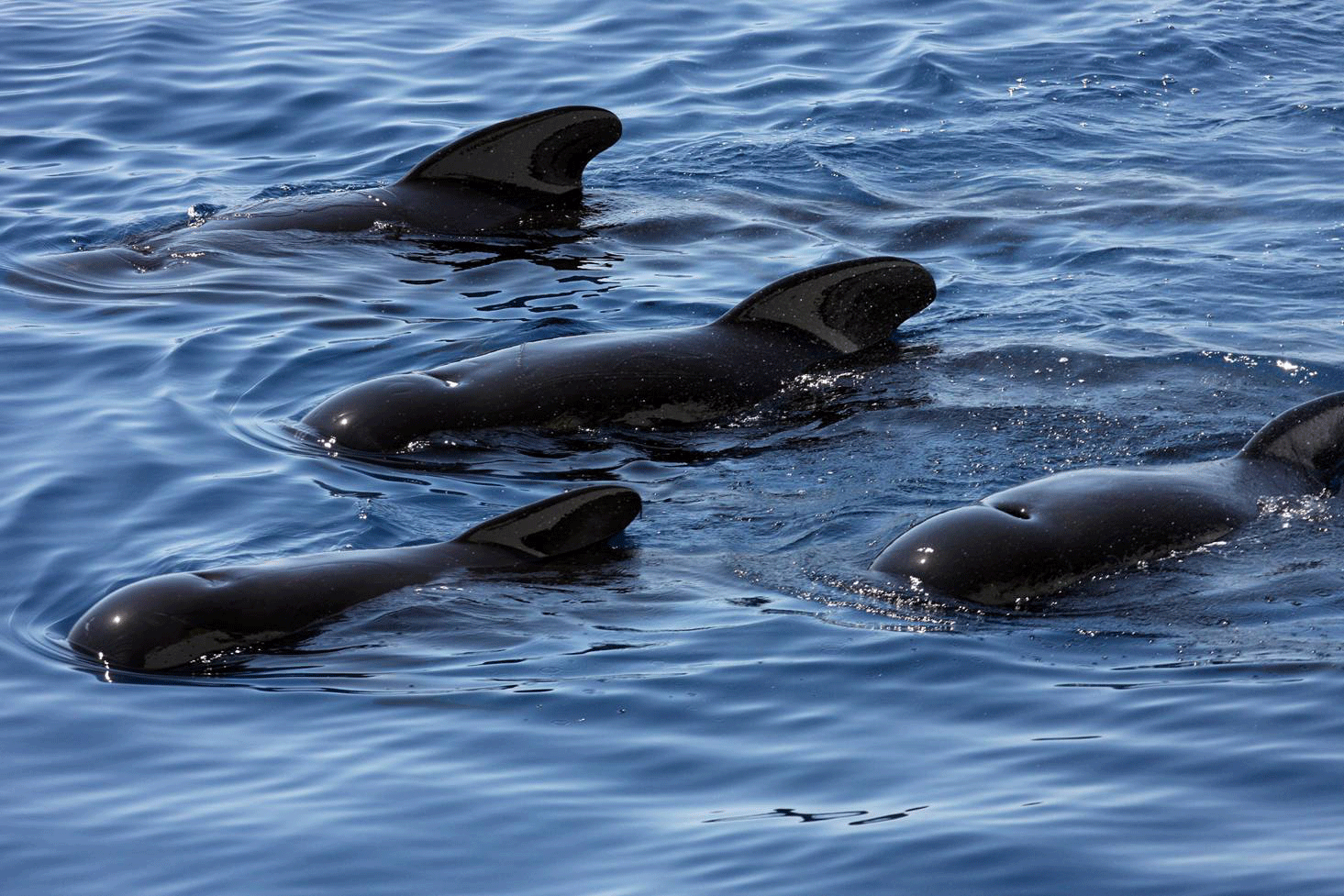
Long-finned pilot whales roam in large pods with hundreds of individuals and cluster in smaller groups like this one, photographed in the Alboran Sea (Western Mediterranean) during a WHOI research expedition in 2011. (Photo: Woods Hole Oceanographic Institution)
JERRETT: Jensen says that a noise like that could interfere with a dolphin’s ability to communicate, to find food or to avoid predators. There's a growing body of evidence that noise affects both the behavior and the physiology of dolphins. Much of the work that’s been done in marine bioacoustics has focused on these animals. As Aran Mooney says…
MOONEY: They're sorta the laboratory mouse of the marine mammal world.
JERRETT: What's new is what scientists are learning about the role of sound for other, more unusual, sea creatures, like the squid. Back around 2008, Aran Mooney made a discovery. Not only do squid detect sound, but they do so in a pretty wild way.
MOONEY: The best way to kinda think about how squid detect sound is to kinda think about fruit in Jell-O.
JERRETT: You heard that right; fruit, in Jell-O.
MOONEY: So sort of that Midwest delicacy where you kinda make your salad with the fruit in the Jell-O. The squid being the fruit and the Jell-O being the water column. And how squid detect sound is that essentially the sound wave literally vibrates them or moves them back and forth.
JERRETT: So, squid can feel themselves getting physically jostled by the sound wave. Essentially, they hear with their whole bodies. But squid aren't necessarily using sound to talk to each other. Instead, they might be using sound in some unexpected ways.
It’s a really new idea, but Mooney is beginning to think that young squid along with other larval invertebrates might use sound to navigate – that they cue in to the ambient sounds around suitable habitats, sounds made by waves, snapping shrimp or other animals that are common in those habitats.
[SOUNDS OF SNAPPING SHRIMP AND DACYLLUS]
And Mooney’s latest research suggests that adult squid might rely on sound for different information – to alert them that predators are nearby.
MOONEY: The thing about working with squid is that there’s a range of responses. They can ink, they can change color and they can jet, meaning that they can swim away really fast and when we play a really abrupt predator type sound they do all three: they ink in the water, they swim away really fast and they’re doing color changes at the same time.
JERRETT: Is this something that has surprised you?
MOONEY: It’s definitely sort of surprising I feel like to a lot of the marine community. The fact that maybe we’re seeing some differences in adults and young is pretty neat. And, um, the fact that there's a key way that these guys are interacting with their environment and other animals that we didn't know about, that's pretty awesome. Pretty astounding.
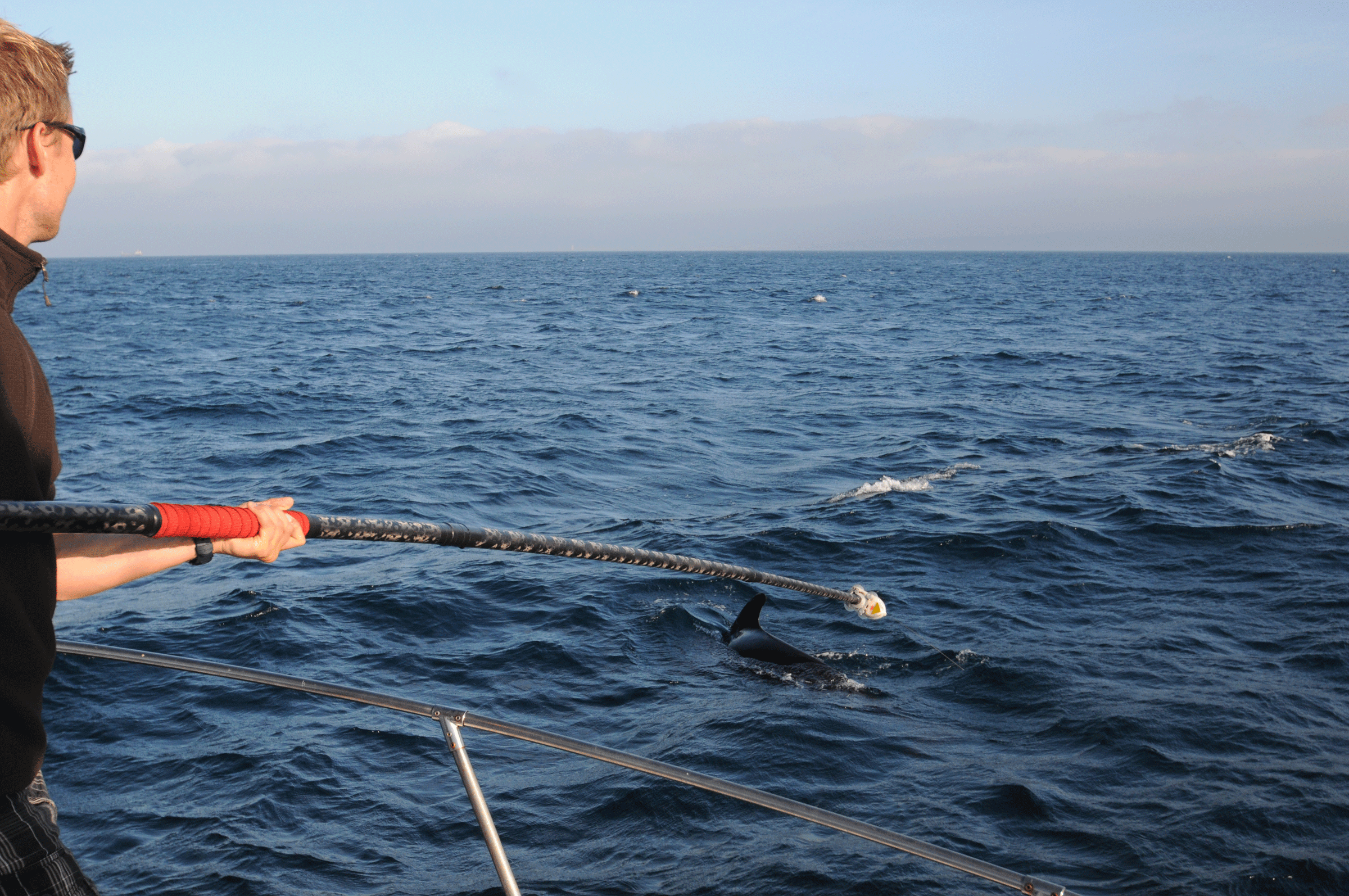
Frants Jensen tagging pilot whales in the Strait of Gibraltar. This research was performed under NMFS Marine Mammal Permit number 14241. (Woods Hole Oceanographic Institution)
JERRETT: Mooney doesn't know yet whether squid are affected by human created noise. That's one of his next projects. And he's looking at the relationship between sound and human activity in the ocean in other ways, too. His team is putting recorders in the ocean to monitor acoustics at the site of America's first proposed offshore wind farm -- in Nantucket Sound. They’re listening for what’s out there; both before and after the wind turbines go in.
[QUIET AMBIENCE OF NANTUCKET SOUND]
MOONEY: We want to know how those different patterns change; how often does the animal habitat use of the area change or how does the human habitat use change. It’s actually kind of an interesting place 'cause it’s relatively quiet. So um it might be a really great place to put a wind farm. We don’t know quite what to think about it yet.
JERRETT: Incorporating sound monitoring into offshore environmental planning is a pretty new approach. It's another way science can help people understand what's at stake with increasing human activity in the ocean. To start asking questions about what we should and shouldn't do. Frants Jensen puts it this way.
JENSEN: From a policy perspective, I think it's very important to strike a balance between being conservative and commercial development and we need to listen to what we can actually say with our data. Of course, there's going to be some impacts if you're putting out a water turbine or a wind turbine during offshore construction. What we really need to find out as researchers is how big those impacts are and whether, for that sake, they're worth the cost.
JERRETT: As humans put more pressure on ocean habitats and the creatures that live there, bioacoustics and the role of sound will have more to tell us. For now, Jensen and Mooney plan to keep listening.
For Living on Earth, I'm Jennifer Jerrett at Woods Hole Mass.
Related link:
Follow Jennifer Jerrett’s work on this story and others on SoundCloud
[MUSIC: Jan Hammer “Oceans And Continents” from The First Seven Days ( Sony Music 1975)]
CURWOOD: Coming up - The lengths - and depths - some sea creatures go to survive and thrive. That's just ahead on Living on Earth – stay tuned.
ANNOUNCER: Funding for Living on Earth comes from United Technologies, a provider to the aerospace and building systems industries worldwide. UTC Building & Industrial Systems provides building technologies and supplies container refrigeration systems that transport and preserve food, and medicine with brands such as Otis, Carrier, Chubb, Edwards and Kidde. This is PRI, Public Radio International.
[CUTAWAY MUSIC: David Sanborn: “One Hundred Ways” from Straight To the Heart (Warner Bros 1984)]
BirdNote: Gliding with Tropicbirds
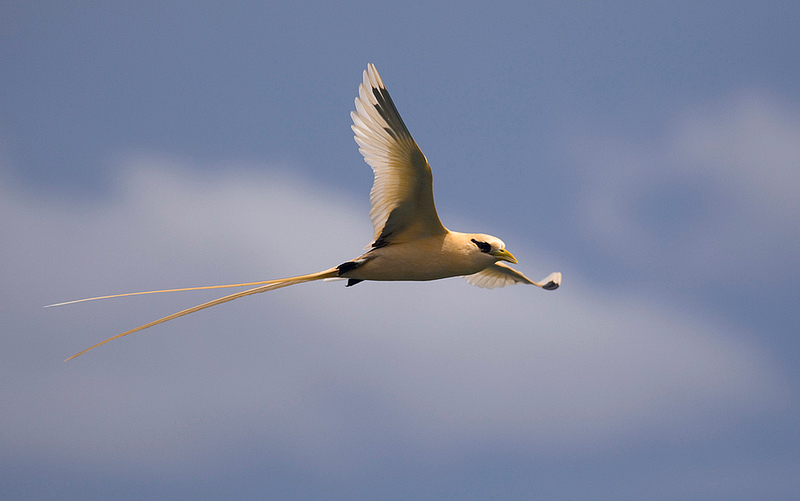
White-tailed Tropicbird (Photo: Budak)
CURWOOD: It's Living on Earth, I'm Steve Curwood.
[BIRD NOTE® THEME]
CURWOOD: And now let's head to the sun-soaked beaches of Hawaii for today's BirdNote®.
Here's Mary McCann.
MCCANN: "Tropicbird." The name alone evokes a warm breeze and a place where green islands dot a shimmering blue ocean.
[MUSIC: “Aloha Wau la Oe” by P. Cosma. Performed by the Ho’opi’i Brothers, from “Aloha From Maui”: Mountain Apple Company: 1999]
MCCANN: Picture a streamlined, sparkling white seabird, with a red spear of a bill and luxuriantly long tail-streamers. With the strong, direct flight of a falcon, a tropicbird can catch a flying fish on the wing, or plunge like an arrow into the sea and—with its serrated bill—capture a squid.
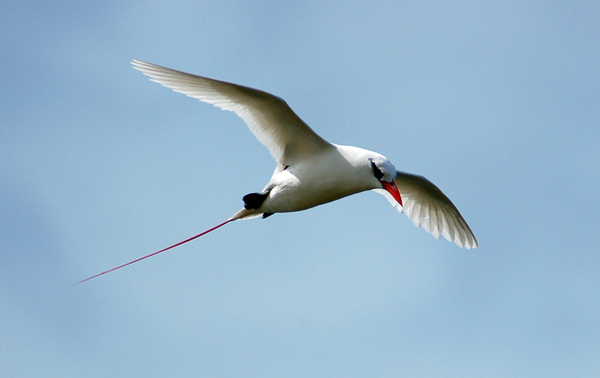
Red-tailed Tropicbird in flight (Photo: Matt Knoth)
[RED-TAILED TROPICBIRD VOCALS]
MCCANN: Birds of such elegant natural design seem creatures of myth. And in fact, their scientific name links directly to Greek mythology, as tropicbirds belong to the genus Phaeton. Phaeton, the son of Apollo, hurtled through the sky in the chariot of the sun, only to plunge into the River Eridanus.
Myth, sun, and sea – there’s that warm ocean breeze again.
[MUSIC: “Aloha Wau la Oe” by P. Cosma. Performed by the Ho’opi’i Brothers, from “Aloha From Maui”: Mountain Apple Company: 1999]
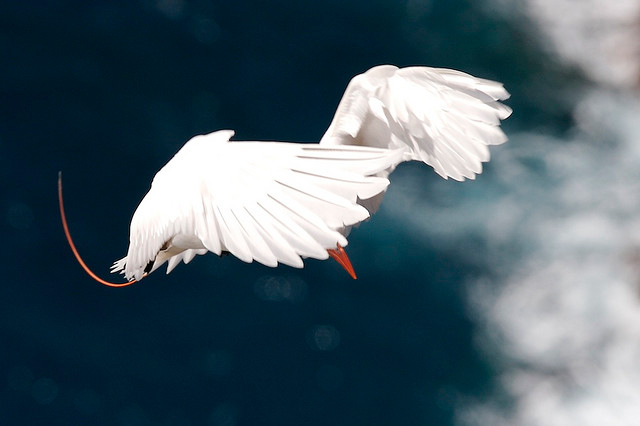
Red-tailed Tropicbird (Photo: Scott Henderson)
Maybe it’s time for a trip to Hawaii. Visit the island of Kauai, and you can easily see one of these near-mythical birds, its glistening white form floating in the air just beyond a sea cliff’s edge. Tropicbirds have ranged through most of the tropical latitudes of the world’s oceans for 60 million years.
I’m Mary McCann
CURWOOD: There are pictures of these magnificent birds at our website, loe.org.
Related links:
- Check out this episode of BirdNote on their website
- Read more about tropicbirds
[MUSIC CONTINUES]
The Extreme Life of the Sea
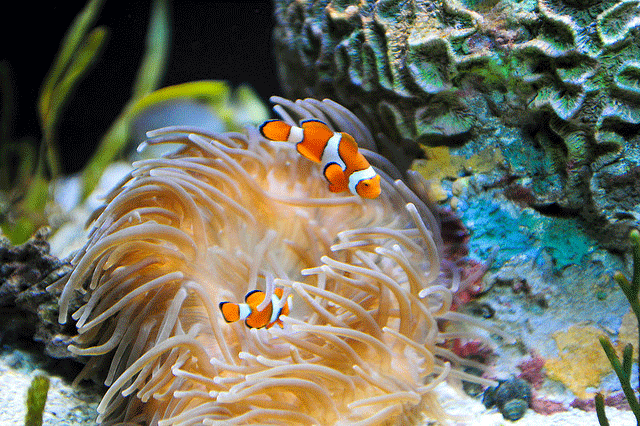
For clownfish, the bigger the better (Photo: Eddie.Welker; Flickr Creative Commons 2.0)
CURWOOD: They say that a period at the end of a sentence represents how much—or how little—we know about the world’s oceans. This underwater universe seems alien to most of us, but it represents the essence of life on this planet. In an engaging recent book called The Extreme Life of the Sea, biologist Steve Palumbi and his novelist son Tony deepen our understanding of how strange sea life has managed to survive against all odds. Joining us is half of the pair of authors - Steve Palumbi, a professor of marine biology at Stanford University. Welcome to Living on Earth!
PALUMBI: Hi Steve. It's a pleasure to be here.
CURWOOD: Why did you write this book? Why now?
PALUMBI: Well, the real reason is that we’re trying an experiment: can you take the narrative style and approach that a novelist would use and combine it with what a scientist would do? And come up with an environmental narrative that is more engaging than we’re used to. It’s all sort of, in a small way, described by a simple phrase: that you don’t really care about the plot until you care about the characters, and so we wanted to write a book that made you care about the characters.
CURWOOD: Now, you write about the extreme life of the sea, the oldest, the hottest, the shallowest, to name a few. Why did you choose this approach?
PALUMBI: Because it was a way of getting people’s attention to the really sort of amazing things that these critters do. Organisms in the sea live in some of the hottest places, they live in some of the coldest places, and how they do that is something marine scientists have paid a lot of attention to. So it was really a way to make it more engaging, more fun, and to let us move credibly between different kinds of organisms all in the same chapter.
CURWOOD: Now, which of these particular extremes did you like and why?
PALUMBI: I was most surprised by all the information we got about the oldest creatures in the sea.
CURWOOD: And the oldest are?
PALUMBI: Well, the oldest by far is that set of deepwater corals off the coast of Hawaii. Black corals, they live in about 1,000 feet of water. It’s dark, it’s steady currents, it’s a very, very, calm and steady environment. And those corals are clocked, the oldest one we know about, at 4,200 years old.
CURWOOD: That’s old.
PALUMBI: That’s old. I mean, these corals we’re alive before some of the pyramids were started.
CURWOOD: Speaking of age, you had one extreme that you called immortal.
PALUMBI: That’s an amazing jellyfish called turritopsis, and it has the remarkable ability to age in reverse. So when the environment is bad, this animal can essentially go from its adult body form back, back, back to its larval form, and then start all over again.
CURWOOD: It’s reborn, huh?
PALUMBI: It’s reborn. It’s called transdifferentiation. It’s the only critter known to be able to do that.
CURWOOD: Hmmm. Wonder if I could package that?
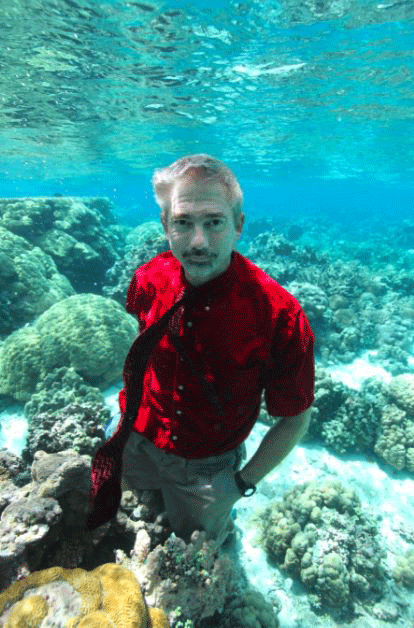
Coauthor and scientist Stephen Palumbi, doing some research on corals (Photo: Dan Griffin, GG Films)
PALUMBI: [LAUGHS] Well, you know, there’s lots of movies about when you all of a sudden wake up and you find you’re back in high school, and so do you really want to do that, Steve?
CURWOOD: Oh, I don’t need to go back there.
PALUMBI: Think about it. [LAUGHS]
CURWOOD: Tell me about your favorite from the deep, deep, deep.
PALUMBI: One is this amazing critter called the Stoplight Loosejaw. Like typical deep sea fish, it’s got fangs and a huge jaw and amazingly sharp teeth. It can actually eat a fish bigger than itself. The deep sea is extreme in that it’s dark, and there’s also not much food. There’s bioluminescence, flashes of blue and green that are down there, and if you use your light as sort of a search light to find something then everybody else can see you too, and come after you.
So the Stoplight Loosejaw fixes that problem by cheating. It has two searchlights that beam out from under its eyes, and they’re not the typical blue-green of bioluminescence. Those searchlights are red, and they also change their eyes so that they can see red. So the only fish down there that sees red, and then produces red light. So they can prowl around with these search lights on and nobody else can see them, but they can see their prey.
CURWOOD: So a predator with night vision.
PALUMBI: A predator with night vision goggles essentially, yes, so imagine if you’re some laser tagger in an arena and you’re the only one who can actually see anybody else.
CURWOOD: Describe the whale fall and why these are important.
PALUMBI: The whale fall is an amazing exception to the generalization that the deep sea has not got much in the way of food. When a whale dies, it often dies in the middle of the ocean in deep water, and it falls down to the bottom of the sea with a sort of plumph that dumps tons of meat and bones and gristle all at once. It’s an incredible instant oasis of food, and from all around, critters come immediately to start feeding on it, and they disassemble the whole skeleton in just a matter of weeks. But it goes beyond that because a set of predators comes in to eat the critters that are eating the whale, and they slowly all form this community - short-lived community - until most of the whale is gone. And then you have the bones left, scattered around the bottom, but the bones of the whale are actually enormously valuable for food. They’re full of oil. So another set of critters comes and lands on those bones and starts feeding on those. Finally, all you’re left with is just a thin dusting of the remains of an entire whale and all the bones on the bottom of the sea floor.
CURWOOD: Now there’s some pretty interesting sex lives. Tell me about these.
PALUMBI: [LAUGHS] It turns out one of the most extreme things about marine critters is their family lives. For example, another deep sea example is the Anglerfish, made popular in the “Finding Nemo” movie, have a remarkable lure that attracts prey to them. And scientists studied them for a century or more, always bemoaning the fact they could only find females. And then a parasitologist was working on them looking at the parasites that these females always seem to have hanging off them and discovered that those were the males. They were parasitic males attached to the females, and living only with them, depending totally on the females for everything. After they bite the female their jaws dissolve, and then their brains dissolve, and then their guts dissolve and then their blood systems mesh with the females, and all they are just at the end is a testes that’s there to fertilize the female’s eggs when she’s ready.
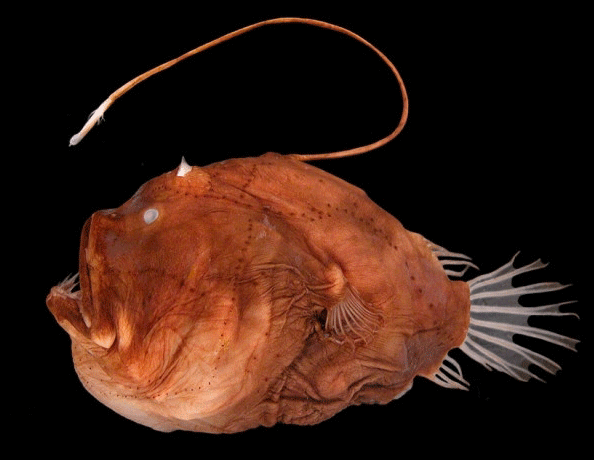
Anglerfish use bioluminescence to attract their prey in the darkest depths of the ocean (Photo: Masaki Miya et al.; Wikimedia Creative Commons)
CURWOOD: I thought you weren’t going to talk about human relationships here.
PALUMBI: [LAUGHS] Well, when we give these book talks, the women are usually laughing, the men are somewhat bemused, and then, by the end, the men are all horrified.
CURWOOD: One of the most fascinating parts about your book is how you tell the story of evolution through microbes in the ocean. What made you decide to do that?
PALUMBI: Microbes are the smallest creatures in the ocean, but they are by far the most numerous, and you can’t understand the life of the ocean without including them. They are, in fact, the organisms that determine that the ocean is livable. You might be referring to the evolution part to a sort of scary, shivering, chilling type of process that biologists have called “kill the winner”. And here’s the way it goes. The microbes in the sea, you think the best one would take over...the one that could grow the fastest in the most places, but that doesn’t happen. The microbes in the sea are incredibly diverse, and it boils down probably to the enemies of these microbes, and those are viruses, and any microbe that gets good enough and big enough and abundant enough to maybe take over the ocean is also a target for viruses that evolve to attack them specifically. So the viruses are constantly killing the winner of the competitive race among microbes in the ocean, and by doing that, they’re keeping the ocean in balance and highly diverse.
CURWOOD: Now, how does the human consumption of seafood affect the marine ecosystem and the balance of bacteria?
PALUMBI: You know, Steve, the real problem is that this huge ocean with all these creatures in it is not big enough that is immune to the kinds of changes that we can make in it. In particular, overfishing has the effect of breaking the food chains that the ocean normally has. And you can think of the food chain as taking the smallest little critters, and they’re food for the next larger ones, and they’re food for the next larger ones up. And so the food energy in the ocean - or any ecosystem really - moves from the smallest critters up through the bigger and bigger and bigger ones. But when we fish, especially fish heavily, we break the food chain. We end up, essentially, allowing the food energy to clump up at parts of the food chain that it doesn’t usually. So we get big huge blooms of jellyfish, for example, with the ocean out of balance by us overfishing.
CURWOOD: Talk to us about how climate change is affecting the life of the sea.
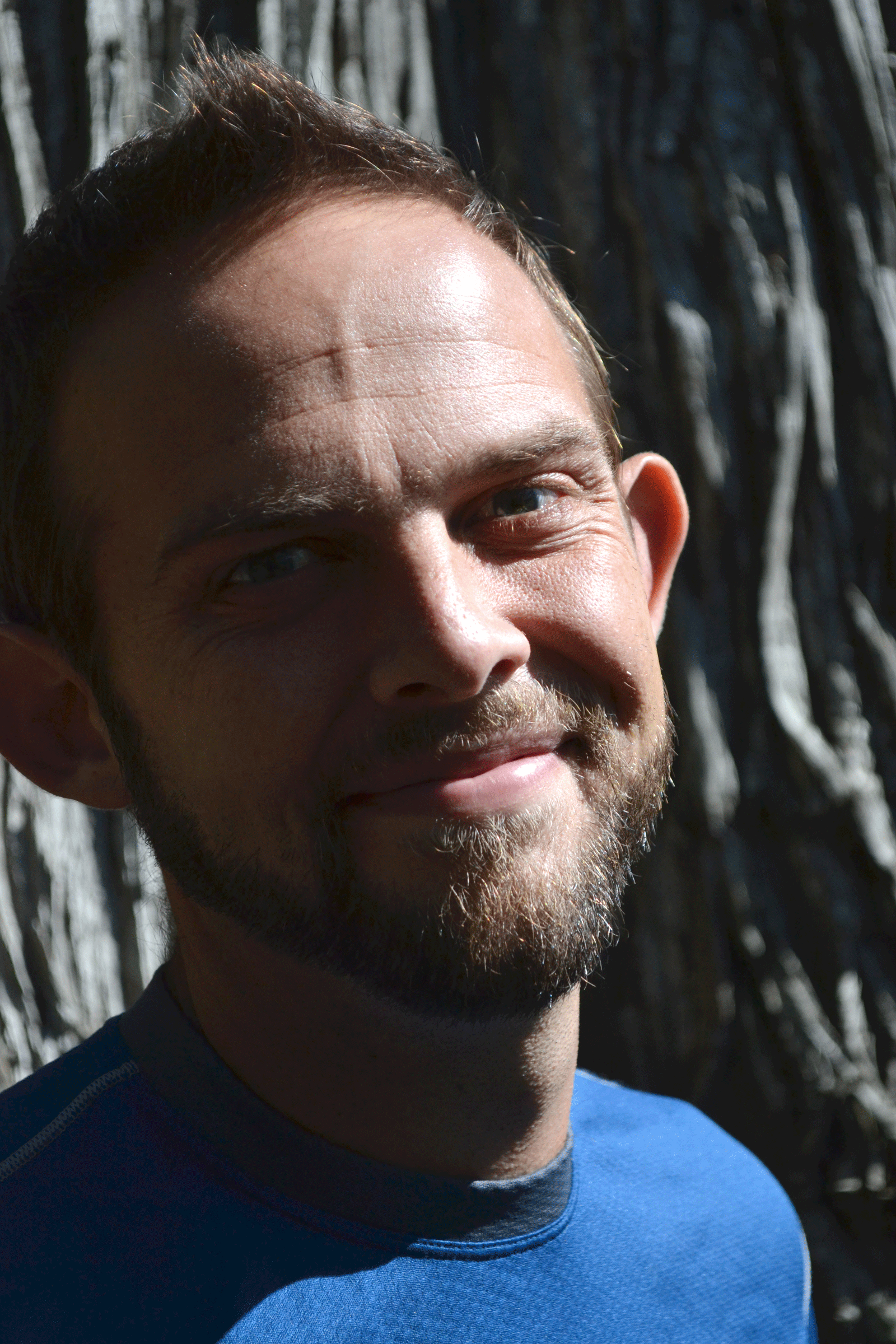
Coauthor and writer Anthony (Tony) Palumbi (Photo: Dan Griffin, GG Films)
PALUMBI: So climate change is a pervasive, growing and huge problem. It’s, of course, making the sea level rise. It’s also making the oceans warmer, it’s making them more acidic and stormier. And all these things mean that how we interact with the ocean is getting harder and harder, and a lot of the organisms that we might depend on to grow barriers, natural living sea walls, for example, around our coast are succumbing to extra heat and the acidification. And these problems are visible now, and they’re projected to grow into the future. If we stopped the process by which climate change is happening, which is, we stop carbon emissions, it’s still going to take 50 years or so for the oceans to absorb what we’ve already put into the atmosphere and begin to get better.
So it’s like you’re booming along in a speeding car, and all of a sudden you see the red brake lights in front of you, and you think, “OK, we’ve got to stop,” but there’s a stopping distance. You can’t stop immediately. You can’t stop a speeding car right on a dime. It takes a while. And that stopping distance for climate change is about 50 years, so the biggest problem is that we’re just now beginning to see the red lights in front of us, and even if we all decided, “OK, we’re going to put the brakes on now,” which we have not yet decided, but if we did, we’d still have 50 years of stopping distance before things got better.
CURWOOD: Steve, what do you hope readers will take away from your book?
PALUMBI: We wrote the book to give readers a sense of guiltless wonder about how wonderful the life of the ocean is, and that these critters out there are not just seafood, they live in all the corners of the ocean, they can live and thrive in amazing places with amazing abilities, and that they add to the wonder of our planet. It’s really a book that’s meant to entertain people, it’s meant to give them the sense of, “Wow, I never knew that.”
CURWOOD: Steve Palumbi is a Marine Biologist at Stanford University and co-author of “The Extreme Life of the Sea”. Thanks so much for taking this time today, Steve.
PALUMBI: Hey, Steve, it’s an absolute pleasure. Thank you.
Related links:
- The Extreme Life of the Sea Tumblr
- Extreme Life – Shark
[MUSIC: Ledward Kaapana “Kalana Na Pua” from Grandmaster Slack Key Guitar (Rhythm And Roots Records 2006)]
CURWOOD: Next time on Living on Earth, Scots are about to vote on independence from the UK – and debating if their prosperity rests entirely on offshore oil reserves.
BANKS: We have alternative resources here, we’ve started to tap into them. We think that’s the future that Scotland should be taking, not continuing to take every last drop of oil out of the North Sea.
CURWOOD: Scotland the brave – and green? That's next time on Living on Earth.
CURWOOD: Living on Earth is produced by the World Media Foundation. Naomi Arenberg, Bobby Bascomb, Emmett Fitzgerald, Helen Palmer, Adelaide Chen, James Curwood, Lauren Hinkel, Jake Lucas, Abi Nighthill, Jennifer Marquis, and Olivia Powers all help to make our show. We also had help this week from Rosa Curson-Smith. Jeff Turton is our technical director. Alison Lirish Dean composed our themes. You can find us anytime at loe.org – and like us on our Facebook page – it’s PRI’s Living on Earth. And we tweet from @livingonearth. I’m Steve Curwoond. Thanks for listening!
ANNOUNCER1: Funding for Living On Earth comes from the Grantham Foundation for the protection of the environment, supporting strategic communications and collaboration in solving the world’s most pressing environmental problems. The Kendeda Fund, furthering the values that contribute to a healthy planet, and Gilman Ordway for coverage of conservation and environmental change. Living on Earth is also supported by Stonyfield Farm, makers of organic yogurt, smoothies and more. www.stonyfield.com.
ANNOUNCER2: PRI. Public Radio International.
Living on Earth wants to hear from you!
Living on Earth
62 Calef Highway, Suite 212
Lee, NH 03861
Telephone: 617-287-4121
E-mail: comments@loe.org
Newsletter [Click here]
Donate to Living on Earth!
Living on Earth is an independent media program and relies entirely on contributions from listeners and institutions supporting public service. Please donate now to preserve an independent environmental voice.
NewsletterLiving on Earth offers a weekly delivery of the show's rundown to your mailbox. Sign up for our newsletter today!
 Sailors For The Sea: Be the change you want to sea.
Sailors For The Sea: Be the change you want to sea.
 Creating positive outcomes for future generations.
Creating positive outcomes for future generations.
 Innovating to make the world a better, more sustainable place to live. Listen to the race to 9 billion
Innovating to make the world a better, more sustainable place to live. Listen to the race to 9 billion
 The Grantham Foundation for the Protection of the Environment: Committed to protecting and improving the health of the global environment.
The Grantham Foundation for the Protection of the Environment: Committed to protecting and improving the health of the global environment.
 Contribute to Living on Earth and receive, as our gift to you, an archival print of one of Mark Seth Lender's extraordinary wildlife photographs. Follow the link to see Mark's current collection of photographs.
Contribute to Living on Earth and receive, as our gift to you, an archival print of one of Mark Seth Lender's extraordinary wildlife photographs. Follow the link to see Mark's current collection of photographs.
 Buy a signed copy of Mark Seth Lender's book Smeagull the Seagull & support Living on Earth
Buy a signed copy of Mark Seth Lender's book Smeagull the Seagull & support Living on Earth

